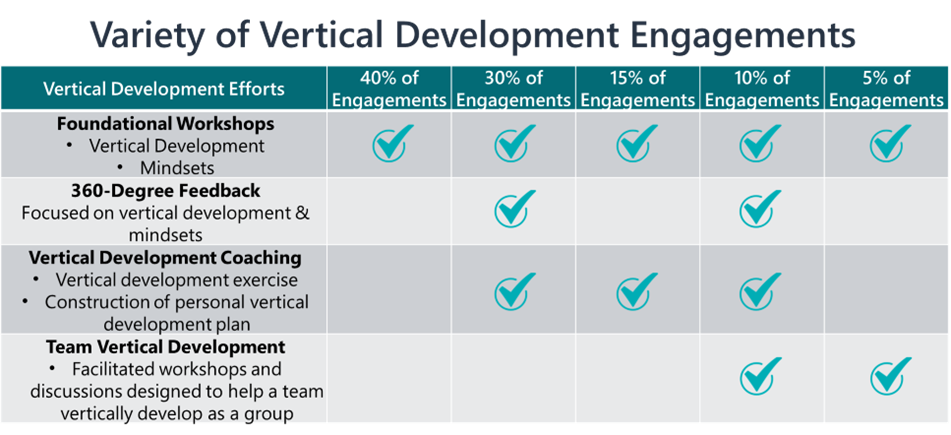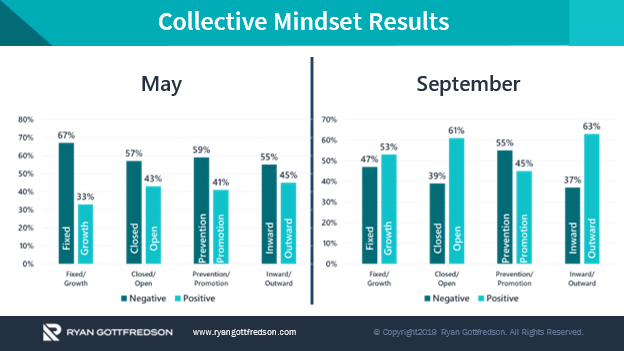A few weeks ago, I surveyed my newsletter subscribers and asked them what they would like to see me write about. A common theme from the responses was that they wanted to learn more about my business and the impact that it is having on the leaders and organizations that I work with.
So, over a series of a few weeks, I am sharing:
- Two weeks ago: The Evolution of My Consulting Business
- Last week: The Impact of Vertical Development on Individual Leaders
- Today: The Impact of Vertical Development on Organizations
Common Vertical Development Efforts that I Engage In
When I work with organizations on vertical development, I generally have two different types of audiences:
- Groups of leaders (generally mid-level managers and above)
- Leadership teams (generally executive teams)
When I work with “groups of leaders,” generally, I am just doing foundational workshops for them on vertical development and mindsets. Sometimes those are one-off workshops. Other times, they are a workshop series.
When I work with “leadership teams,” I am doing some foundational workshops, but I am also doing something more, which can include:
- 360-degree feedback
- Vertical development coaching
- Team vertical development efforts
Here is a rough breakdown of how this looks in my consulting practice.

As you can imagine, I see the largest impacts with the leaders (1) that I work with for the longest, and (2) engage in more vertical development efforts.
I am going to share my experience working with organizations where I have done:
- A substantial amount of work with their executive teams (essentially the fifth column in the table above; 10%)
- Only workshops with their organizational leaders (essentially the second column in the table above; 40%).
Organization #1 – Working with the Executive Team
I have been working with this executive team for just over a year. They are a group of 10 executives who are at the helm of an organization with 1,200 employees and operate in the healthcare technology space.
When I first met this team, the executives were high-level Mind 2.0 leaders. They were competitive with each other resulting in strong silo behavior, and they were extremely results-focused. For example, when I asked the COO, “How do you measure success in your organization?” She said, “Double-digit growth year-over-year.”
All members of the executive team seemed locked in and focused on what the board of directors wanted, which was double-digit growth year-over-year. When they held all-hands meetings, numbers and results were always the priority.
The culture that had developed as a result of this Mind 2.0 mentality was hierarchical and there was no room for failure, mistakes, or problems. The result of this was that the organization really struggled to be innovative and creative.
Between being results focused and not creating space for failure, they only wanted to do what had worked in the past, and were unwilling to embrace new ways of operating.
After a year of working with this team, here are the effects that I have seen:
- They have gone from being results-focused to being purpose-focused (they have spent the last six months focusing on developing a new organizational purpose).
- They have become “gardener-minded leaders.” Before, they cared only about the fruits, but now they are more focused on cultivating the right conditions for their employees to grow and thrive.
- They have gone from being competitive with each other to being collaborative.
- With the shift from being more purpose-focused and less competitive, there is greater trust and support in the organization.
- I believe that this team has shifted from being high Mind 2.0 to being Mind 3.0.
It feels like a very different organization than what it was a year ago. I have definitely seen the following laws of vertical development be fulfilled for this organization:
1. As leaders elevate in their vertical development altitude, they become more capable of effectively navigating tumultuous market conditions because they can:
- Better regulate themselves (responders vs. reactors)
- See further (long-term vs. short-term)
- Think more strategically (purpose-driven vs. outcome-driven)
2. Leaders put into place organizational structures, practices, and policies that emerge from their vertical development altitude
3. The culture of an organization is a reflection of its leaders’ vertical development altitude
4. Organizations cannot evolve beyond their leaders’ vertical development level
5. The most effective way of transforming an organization is to help its leaders elevate in their vertical development altitude
Organization #2 – Working with all Employees
This organization is a 400-employee production company in the agricultural space. They wanted to vertically develop all employees through a focus on mindsets. They didn’t have a huge budget, so we decided to do the following efforts:
- I would give an introductory workshop to all employees to help them learn about vertical development, the power of mindsets, and the four different sets of mindsets.
- In preparation for this workshop, everyone would take my mindset assessment, which would allow me to present a collective mindset report to all employees during the introductory workshop.
- Shortly after this workshop, the HR team would facilitate a number of book clubs on my book, Success Mindsets (They ended up getting about 1/3rd of employees to participate in a book club).
- Six months after the introductory workshop, we would have all employees complete the mindset assessment to track the impact of our efforts.
Honestly, we were not doing a lot, and I was a bit skeptical that we would see much effect on the organization. But, was I wrong!
Here are their mindset results from Time 1 to Time 2:

For three of the four mindsets, there are significant swings.
While our workshops and book club were a relatively small investment, the consequence was a significant positive shift in their culture. For some in the organization, they considered a night-to-day shift. Before they were rigid and change-resistant. After, they were energized and much more agile.
Summary
Not only are these shifts game-changing for the organizations, but the improvements in these organizations have been world-changing for the employees within their organization.
I am truly coming to learn that the most effective way (and I think the only way) to elevate an organization is to help its leaders and employees elevate in their vertical development altitude.
If you would like to learn more about vertical development, here are some helpful resources:
- My website
- Video: What is Vertical Development?
- Video: Investigating the Sophistication of Your Executive Team
- Book: The Elevated Leader: Level Up Your Leadership Through Vertical Development
- Free Vertical Development Assessment
- Free Personal Mindset Assessment
- Additional Resources
And, if you would like to partner with me to elevate your organization through vertical development efforts, connect with me here.










